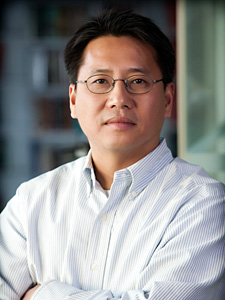Prof. Tianquan (Tim) Lian: Solar Energy Conversion Using Artificial Atoms, Molecules and Solids (2014/07/18) |
| ( 2014-07-17 ) |
Title | Solar Energy Conversion Using Artificial Atoms, Molecules and Solids | Speaker | Prof. Tianquan (Tim) Lian
Department of Chemistry, Emory University, Atlanta, USA |  | Time | 10:00am, July 18, 2014 | Place | Room 9004, HFNL | | Brief Bio of the Speaker | Tianquan (Tim) Lian received his PhD degree from University of Pennsylvania (under the supervision of late Prof. Robin Hochstrasser) in 1993. After postdoctoral training with Prof. Charles B. Harris in the University of California at Berkeley, Tim Lian joined the faculty of chemistry department at Emory University in 1996. He was promoted to Associate Professor in 2002, Full Professor in 2005, Winship Distinguished Research Professor in 2007, and William Henry Emerson Professor of Chemistry in 2008. Tim Lian is the Co-Editor-In-Chief of Chemical Physics (since 2012), a Kavli fellow (since 2012) and a recipient of the NSF CAREER award and Alfred P. Sloan fellowship. Tim Lian research interest is focused on ultrafast dynamics in photovoltaic and photocatalytic nanomaterials and at their interfaces. | Abstract | Quantum confined semiconductor nanocrystals have emerged as a new class of light harvesting and charge separation materials in photovoltaic and photocatalytic devices. Compared with single component quantum dots (or “artificial atoms”), semiconductor nanoheterostructures (or “artificial molecules”), consisting of two or more component materials, offer additional opportunities to control charge separation properties by tailoring their compositions and dimensions through wavefunction engineering. With (quasi-) type II band alignment, both fast forward charge transfer (charge separation and hole filling) and slow backward recombination (charge recombination and exciton-exciton annihilation) can be achieved, enhancing the charge separation efficiency. Near-unity quantum yield of redox mediator (methylviologen radical) generation can be obtained in asymmetric CdSe/CdS dot-in-rod nano-heterostructures. When coupled with catalysts (Pt), these nanorods led to a much higher solar-driven hydrogen generation efficiency compared to molecular dyes and other nanocrystals. Quantum dots can also form “Artificial solid” electrodes with high carrier mobility and strong quantum confinement effect, enabling their integration into photoelectrochemical water splitting devices. In this talk, we will discuss how the fundamental charge transfer dynamics in these nanostructures can be directly probed by time-resolved spectroscopy and used to guide the design and optimization of nanoheterostructures for efficient light-driven H2 generation. (Relevant publications: Acc. Chem. Res. 2013, 46, 1270-1279, JACS (2014), DOI: 10.1021/ja5023893. Nano Lett. (2013), 13(11), 5255-5263, (2014), 14, 1263-1269)
|
|
|
|
